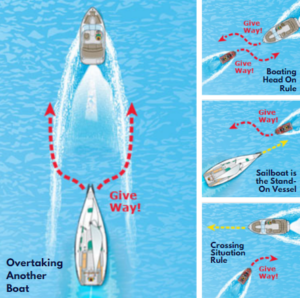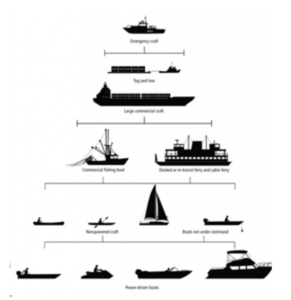Looking down from a bridge onto the pristine Canadian waterways we see many boats coming and going from the marinas and harbours. As easy as it looks with no road lines or stop signals, there is a comprehensive system to navigating on the water and among other boats. If you are new to boating, it is critical you learn, and memorize boating navigation rules.
As free and as easy the boats on the water appear to be from the bridge’s point of view, down below there is a hierarchy or pecking order among the watercraft, and some very serious, specific rules in place that all boat operators must follow to prevent nautical accidents, damage and injury. Boating navigation rules can be tricky, so take time to study rules of the road on water.
The Collision Regulations put forth by the International Maritime Organization govern right of way rules, look out rules and navigation rules for all vessels. It is critical for both new boaters, and experienced boaters to have a clear understanding of the Collision Regulation rules.
Responsible Boating on Canadian Waters
To begin, all boaters must commit to the three major responsibilities of boating navigation rules while operating a pleasure craft:
1) Practice good seamanship by operating in a safe manner and taking all necessary action to avoid a collision.
2) Keep a proper lookout by watching and listening for other vessels, radio transmissions, and navigational hazards. Be aware of your surroundings at all times, and the potential risks for collisions.
3) Maintain a safe speed so you have plenty of time to slow down and stop to avoid a collision. Collision Regulations state that a safe speed varies depending on wind, water conditions, currents, navigational hazards, etc.
To better understand the collision regulation rules, is to know the two following terms:
Stand-on vessel is the vessel that has the right of way and is to maintain speed and direction during an encounter with other vessels.
Give-away vessel is the vessel that must alter speed and direction to steer clear of the stand on vessel.
The following rules include examples of various scenarios that can occur while boating. For a more examples, please refer to the resource section below to be linked to a boaters exam study guide.
Narrow Channel Rule
It’s practically impossible for a large ship to maneuver in a narrow channel to avoid a collision; chances are also good the operators on the bridge won’t be able to see smaller vessels. It is up to smaller vessels to proceed on the starboard side, as near to the outer limit of the channel as safely and practical as possible. Unless the situation calls for anchoring, a vessel must not be anchored in a narrow channel. In the event of over-taking or being over-taken, or if there is a bend in the channel, boaters must use appropriate sound signals and proceed with caution.
Traffic Separation Schemes Rule
Extremely busy shipping areas are heavily regulated and shipping lanes are required to keep the traffic moving and free from collision. A vessel must proceed in the appropriate traffic lane, in the general direction of traffic flow for that lane and keep clear of the separation line/ zone.

Sailing vessel rules
When two sailboats are approaching each other and the wind is on different sides, the sailboat with the wind at its port-side will be the give-away vessel. When both sailboats have the wind on the same side, the sailboat that is to windward will be the give-away vessel. If a sailboat with port-side wind can’t determine without a doubt what side the approaching sailboat’s has the wind, the sail boat with port-side wind is the give-away vessel.
Overtaking rules
The vessel that is overtaking another vessel is the give-way vessel. The vessel being overtaken is the stand-on vessel. Even if the overtaking vessel is a sailboat, it will still be deemed the give-away vessel. The give-away vessel must make apparent changes in speed and direction to safely over take the stand-on vessel.
Head-on rule
How vessels are propelled will determine how an encounter will proceed. For example; if two power driven vessels are approaching head on, neither vessel is the stand-on vessel. Both vessels should turn starboard (to the right). If a power driven vessel is approaching a sailboat head on, the sailboat is the stand-on vessel.
Crossing situation rule
The vessel on the operator’s port (left) side is the give-way vessel. The vessel on the operator’s starboard (right) side is the stand-on vessel. A vessel crossing a river must keep out of the way of a power driven vessels heading upstream or downstream, except on the St. Lawrence River seaward of Ile Rouge. Canals and locks have their own rules. Check out more on Canada’s canals.
Action by give-way vessel
As noted above, the give-way vessel must alter speed and direction well in advance to avoid collision with another vessel. Those actions also must be substantial enough that the operator of the other vessel is aware that the give-way vessel is steering clear. It should also be noted that vessels with more maneuverability will be the give-way vessel to those that have less maneuverability.
Action by stand-on vessel
As noted above, the stand-on vessel has the right of way and must maintain speed and direction. Determining which vessel is stand-on or give-away is dependent on how they are approaching each other and how they are propelled. If the give-way vessel is not adhering to the rule, the stand-on vessel must alter speed and direction to steer away from the path of the other vessel to avoid collision

Responsibility between vessels
New boaters must familiarize themselves with the types of vessels they may encounter on the water so they can perform the correct action and prevent collisions. If boating in areas that include ferry terminals, or commercial fishing and other industry, new boaters must be mindful of which vessels have the right of way. All motorized boats and sailboats under 20 m in length must steer clear of larger, less maneuverable vessels. The chart depicts the hierarchy of watercraft.
Conduct of Vessels in Restricted Visibility
When vessels are not in sight of each other in areas near or in restricted visibility area (fog, mist, rainstorm, falling snow, etc), every vessel must proceed at a safe speed adapted to the prevailing circumstances and conditions of restricted visibility. A power-driven vessel shall have engines ready for immediate manoeuvre. Unless risk of collision does not exist, an operator who hears the fog signal of another vessel ahead, is in a close-quarters situation with another vessel ahead, or detects the presence of another vessel by radar must reduce speed to the minimum at which the vessel can be kept on course. If necessary, the operator should reduce speed to idle speed.
Boating laws are enforced on Canadian waters by the RCMP and/or provincial and municipal police forces. The fine for operating a pleasure craft in a careless manner is $250, and the fine for speeding is $100.
Boat Navigation Resource
The Canadian government’s Collision Regulation with Canada specific modifications in its entirety is available online here.
The online Boat Canada Course Study Guide presents instructional videos as well as animations depicting many different types of vessel encounters and the correct ways to navigate them. Learn more from Boat Canada.
Benefits of taking in-depth boating courses.








